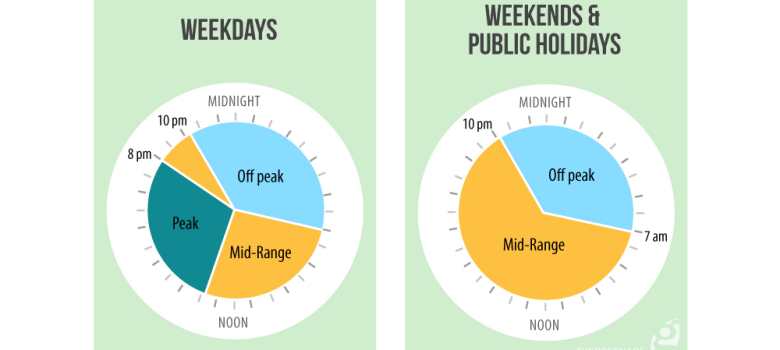
Update: Four years on, the first Time of Use tariff has now been introduced. Read about it here.
Ahead of our launch of the smart grid section on TheGreenAge, I thought I would open with a blog about Time of use tariffs – which in the next decade may become the norm for homes in the UK.
Our current electricity tariff structure
On the whole, the majority of people pay a set price for each kWh of electricity they use as well as paying a standing charge (a daily charge for having an electricity supply in home). This keeps things nice and simple for consumers (despite the number of different tariffs available) since you know that the more electricity you use the more you are going to pay.
Some people have Economy 7 (or Economy 9) energy meters in their homes and this allows them to pay two different prices for electricity – cheaper electricity in the middle of the night, but then they pay a slight premium during the daytime.
The reason for energy companies offering two tier tariff is that nuclear and coal power plants don’t get turned off during the night, so they produce power which needs to be used – so they sell it at about half price (6-7p / kWh) to try and drive demand.
This tariff led to the advent of storage heaters and dual immersion hot water tanks to allow people to use this electricity at a cheaper rate.
The rollout of smart meters
By 2020, the Government want 80% of UK households to have had smart meters installed. The smart meter rollout is absolutely key to the smart grid, which is just about the biggest change to the energy network since its inception.
You can read more about the smart grid here.
One of the features of a smart meter is that it allows two-way dialogue between the household and the energy supplier. So not only can electricity be transmitted from the grid into the home, but also it allows the energy companies to see real-time energy usage.
The advantage of this 2-way dialog for the consumer is that it means the end of estimated energy bills – you are only charged for exactly what you use.
However the ability for the energy companies to see exactly what energy demand is across the network opens up a very interesting possibility – the time of use tariff.
What is the Time of Use tariff?
The time of use tariff would allow energy companies to charge different amounts for electricity depending on the time of day. This is absolutely key for the energy companies since it would allow them to suppress demand during typical peak demand times and encourage usage when energy usage is typically very low.
The benefit of the time of use tariff for the energy company is that they can then avoid building very costly power plants. By suppressing peak demand, peak supply can also be lower – and in theory these savings can be passed on to consumers.
Time of Use tariff – a worked example
So let me show you what this means by way of an example.
At the moment, the price for 1 kWh of electricity is about £0.15, so regardless of whether you use that unit at 11am or 6pm you are paying the same amount.
At about 6pm, everyone comes home from work / school and so typically that is the moment when peak electricity demand occurs. Everyone turns on lights, appliances and their heating. Now imagine if at the moment electricity was £0.30 per kWh, but at 11am it was £0.08. If you continued to act normally your bills would obviously go up, however you could in theory use the minimum energy possible at this peak time when electricity is most expensive and try and do some jobs when you can pay the least (at off peak times) – for example set the washing machine / dishwasher to start on then. This would allow you to pay less on your energy bills.
This time of use pricing (sometimes referred to as time of day pricing) could become the norm when smart meters are rolled out across the country.
Now paying a different price depending on what time you use electricity in the home obviously complicates an already confusing consumer energy market with lots of different providers offering different prices. However for the energy supplier the benefits are clear and also for the consumer, provided they change their energy usage behaviour to use less energy at peak times then there are savings available there too.
Some final thoughts on the Time of use tariff
Obviously between now and the rollout of the smart grid (and therefore the smart meters), it is pretty likely energy prices will have gone up. Over the last 8 years energy prices have gone up on average 8-10% a year, so in a real cash terms basis we are now paying twice as much for electricity as we did in 2005.
We have all seen the backlash to the recently announced energy price hikes by 4 of the big 6 energy suppliers, so obviously energy prices are already genuinely hurting peoples finances – therefore as these prices continue to go up, consumers will take an even bigger interest in energy and energy efficiency. I think as they do this, they will begin to understand more how the energy sector operates and will be more aware of the daily energy demand cycle – so they will know that in the middle of the night energy is cheaper than first thing in the morning or at 6pm.
This should mean that people get to grips with the implementation of the time of use tariffs. For most people it is not going to be an exact science, but if they know generally that electricity is most expensive during the evening hours, they hopefully will start to use energy in a cheaper way (i.e. at offpeak times).











We already use the Economy 7 tariff which means the washing machine/ dishwasher etc only goes on overnight. It makes sense especially if we don’t need to be using the power during the day. Still notice a massive surge in the energy use on our smart meter first thing when we start the day with kettle/ microwave and showers all going on at once!!!
Beware running appliances like dishwashers overnight or when you are out of the house. My 3 year old Bosch dishwasher burst into flames one day and filled the house with acrid black smoke and sooty particles. If I hadn’t been close by and able to put out the flames we would have had a serious house fire to deal with.
The manufacturer replaced the machine free of charge . My assessment was that the fire originated in a chip on the main controller circuit board, ie it was not a wiring fault and neither was it an installation fault.
Many published stories about such fires – just google ‘2011 Bosch issued a product recall’ – or go to this link – http://www.itv.com/news/2013-03-15/a-million-potentially-unsafe-electricals-could-be-in-uk-homes/ which reported that 269 fires had been caused by the Bosch fault, and many at-risk machines have never been inspected.
So you might save on your electricity bill, but put much more at risk if you run these machinnes on timers
Hi Robert,
Thanks for your comment – that sounds horrendous – I have to admit that I was not aware of these issues before you mentioned them! I think from your comment the major piece of advice is to avoid Bosch!
I hate the concept of smart meters. Companies knowing everything I do, controlling how I think through subliminal waves. No thanks sir! Nothing against the blog which is actually a good piece. Keep up the good work but please dont encourage smart meters!
Ernest. I worked for one of the big 3 Australian energy companies.. BTW Australia in the state I worked had smart meters released more than a year ago. I can tell you first had energy companies couldn’t care less about watching or monitoring you. You should be more concerned about a mobile phone or your computer on the Internet. And I have read all the anti smart meter sites etc. But I don’t see there being any more radiation than a mobile phone and WiFi Internet etc combined. Humans have had ill effects however most cases when a smart meter is installed directly near them sleeping.
The major benefit of smart meters is to manage load on the grid.. Over 20% of the UK’s energy needs is imported from places like France.The infrastructure is old and needs serious change to avoid damage and massive risk. Smart meters start that process. UK tests across 60,000 homes 18,000 that had smart meters. Predicted at 15% reduction in usage. However it became clear that after 3-4 months people stopped watching their in home displays and forgot about trying to save more. At http://www.powerhug.uk we know that the UK’s smart meter roll out is not going as smoothly as possible, neither are UK’s carbon emissions reduction targets however with better engagement and focus. We can: Save more than just money. The powerhug app will be coming to the UK soon to help 🙂
GREAT BLOG PIECE THEGREENAGE! Keep it up!
There’s a dilemma here. A smart grid could certainly be greener. But consumers will not save any money and some, possibly all, will be worse off. The huge cost of the smart meter roll out is being paid for directly and indirectly by the tax payer. But in the old days of storage heaters, the companies gradually changed the dual rate tariffs until virtually every dual rate consumer was worse off. If consumers did not recognise this and switch to a single rate meter, they overpaid. The energy suppliers will do similar tricks again. They will also profitably sell the data to other parties, although it is possible to opt out of this. without a shadow of a doubt. They are even more ruthless now, without a shred of integrity. Their only rule is don’t get found out.
Hi Rob, I think you might be right sadly. The hope is the smaller suppliers will continue to keep the Big Six in check. You can see how their market share is decreasing (Big Six versus smaller suppliers) and I think over time this will continue to be the trend and this coupled with smart meter technology hopefully will prevent the energy suppliers doing what they have done in the past.